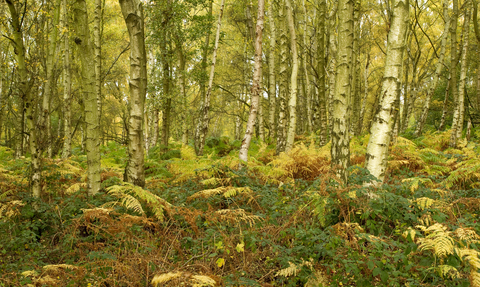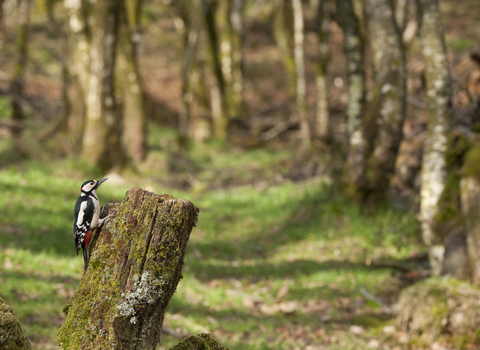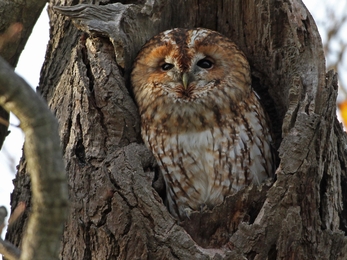Why manage a woodland?
Woodland habitats in the UK are varied and unique, ranging from ancient beech woodlands in the south to native pinewoods in the north, where red squirrels and wildcats roam. Since the last ice age our woodlands have massively reduced in their extent and the UK now has less tree cover than most European countries. Keeping our woodlands full of wildlife is an important job. Anyone who owns a patch of woodland can help make it as diverse as possible for wildlife.
Much of the wildlife within our woodlands now relies on active management to provide a mix of different habitats, from piles of dead wood which can help beetles and fungi to open glades which help butterflies.
The Wildlife Trusts manage hundreds of woodland nature reserves and this often involves a mix of approaches – some areas are managed by coppicing and maintaining open areas like rides and some areas are left to go wild. Often this work is mimicking natural processes like wind and storm damage or grazing by large animals like bison and elephants that would have once lived in our woodlands. Without some form of management many of our woodlands will become dark, over-shaded and dominated by big mature trees without any variation in structure, age or cover. Ultimately this reduces the amount of wildlife that can live in them so we often aim for a mix of habitats in our woodland nature reserves.
Woodlands define the landscape and, whether ancient or young, provide homes for thousands of species of plants, animals and fungi. For people, they provide places to explore and connect with nature and a sense of well-being. They absorb noise, pollution and carbon dioxide, they release oxygen, screen buildings, reduce flooding and provide a source of sustainable livelihoods and timber. By managing woodlands sustainably we are nurturing a habitat that is brilliant for both wildlife and people.
Where do I start?
Before you begin any management work on a woodland, assess what is currently growing and living on site. This will help you work out what management might be best across your site, while avoiding disturbance to rare or protected species. Some species, such as lichens, ferns and mosses, will have taken centuries to build up and can be very quickly impacted by machinery, a change in light conditions or competition with other species. Others may be affected in unexpected ways; for example, bats may be disturbed if the ambient conditions around their roost are altered.
Who can help you do this?
There are likely to be skills and local knowledge within nearby wildlife groups, and individual naturalists and ecologists. You could also upskill yourself and/or your team by going on identification courses offered by Wildlife Trusts or other organisations.
What species are protected?
Some animals, such as hazel dormice, great crested newts and all bat species, need a licensed person to check nest boxes, ponds and roosts for their presence. These animals need to be protected from disturbance and habitat changes. Some breeding bird species also require a licence to visit their nests, including ospreys, barn owls, goshawks and firecrests.
Looking up historical and habitat information about your woodland may give clues as to how it has been previously managed, helping you to plan what to do next. Your local Wildlife Trust can often give professional advice if needed.
How can I manage my woodland sensitively?
To manage a woodland sensitively you want to be replicating all the different things that a vast ancient woodland would have done by itself thousands of years ago, when woodlands were larger. You are ensuring a mix of dead wood, healthy live trees, young saplings and open spaces, such as glades.
Where to begin
Once you know what wildlife you have in your woodland and have an idea of how it has been managed in the past, you can begin to plan what to do and where. If your site is designated, for example, a Site of Special Scientific Interest or an Ancient Semi-Natural Woodland, or included in a Government scheme, you will need to follow the guidelines set out in any agreements.
Coppicing
From before the early Middle Ages until the late nineteenth century many woodlands were managed by coppicing. This involves the periodic cutting back of trees or shrubs to ground level, leaving them to sprout new stems from the cut stumps. This gives rise to the rapid production of small round wood which was used for broom handles, firewood, fencing stakes and hurdles. Coppicing can rejuvenate a tree and allow it to last for many years, meaning it can provide further crops of timber or wood. It also encourages the growth of woodland flowers such as bluebells, primroses and violets by allowing light to the woodland floor.
Coppicing is best suited to ancient woodlands, which were coppiced in the past. Not all woodlands have a past of coppicing. You should only consider reintroducing a cutting regime to woodlands which have been coppiced in the last 60 years or so. If your neighbouring landowners are already coppicing large areas of their woodland, there may be less need to coppice on your land.
Coppicing involves cutting each stem to the stump as close to the ground as possible, at an angle. This is repeated every 5–20 years depending on the species, and can be done in rotation in a chequerboard effect, to ensure minimal disturbance. It is best done in late autumn/winter (November to February) before the buds burst and birds are nesting.
The area to coppice should be between 0.25 and 1 hectare; any smaller and the coppice will not grow well as it will be shaded out.
- Species such as oak and beech are very slow growing, and therefore tend to be left standing as timber trees.
- Very small woodlands are not appropriate to coppice; it may be better to create a shallow coppiced ‘scallop’ along the woodland edge, preferably running east–west.
- Coppiced regrowth is very attractive to deer and rabbits, and repeated browsing can kill the stool. Consider fencing in these circumstances.
Coppicing allows flowering plants and grasses to grow, providing food for insects which in turn provide food for other animals such as birds and bats. Wildlife that benefits from coppicing includes flowers like wood anemones, dog violets, st john’s wort, bluebells, butterflies and moths, bumblebees, dragonflies, slow worms, birds such as nightingales and chiffchaff, some species of bat, such as pipistrelles, dormice and other small mammals.

One year old coppiced woodland, Cloud Wood (Leicestershire and Rutland Wildlife Trust)
Managing open areas like rides, glades and scallops
In your woodland, old pathways and open spaces may have overgrown and simply need opening back up into a ride, glade or scallop. In doing so you are creating woodland edge habitats, where the mix of sunlight, exposure and some shelter combine to create a high level of species diversity. Rides glades and scallops need to be managed to avoid them reverting back to thicker woodland. They benefit many species, particularly rare and declining woodland butterflies such as the small pearl-bordered fritillary and the white admiral.
Rides
A ride is a linear trackway such as a path, designed for access; for example, a public walkway. Where possible, manage rides so they run east to west; these will receive the most sunshine which will help flowering plants, insects and reptiles. However, pay attention to wind direction, as you don’t want to create a wind tunnel that could eventually cause damage to trees. Cut the central part of the ride yearly at the end of summer for a neat finish, then longer grass areas can be cut on a two- or three-year cycle. Remember to remove all grass cuttings to avoid increasing nutrient levels in the woodland soils unnaturally.
Glades
Glades are openings within a woodland; for example, a recently coppiced area. They allow wildflowers and insect species to flourish in the middle of the woodland due to the exposure to sunlight and warmth. However, glades are even better when they are fringed by big trees to provide some shelter. Remember to remove all grass cuttings when managing, but twigs etc. can be piled up to provide cover for animals.
For large woods, rides can be up to 20–30m wide, and a glade can be about half the size of a football pitch
Scallops
A scallop is a semi-circle or D-shaped area along the edge of a path or ride that has been cleared of trees, allowing scrub, herbs and grasses to grow, creating a varied woodland edge. They work well in small woodlands, wide rides or large glades where it is less appropriate to coppice the minimum area. To benefit from the sunshine, a scallop is best placed on the north side of an east–west ride and on the south-facing side of a woodland.
Dead wood
As long as there is no risk of a tree falling on somebody, leaving a dead or dying tree standing can really benefit your woodland’s wildlife. Dead wood will provide food for hundreds of types of animal, fungus, lichen and moss. It will also provide homes to bats, woodpeckers and many invertebrates, such as beetles.
If you feel you are particularly lacking in dead wood, consider ‘ring barking’ unwanted trees. When the dead tree falls, resist breaking it up. A whole tree will be better for wildlife than those that have been cut.
Brushwood and timber from clearing and coppicing should be left in piles, or turned into dead hedges (piles of branches and twigs arranged to form a barrier).
Dead wood is brilliant for all manner of wildlife. Fungi soften the wood through decay, and the larvae of beetles start chewing it up. They in turn provide food for woodpeckers, which make nest holes in the rotting wood. Meanwhile, holes that form where old broken branches have rotted provide crevices for bats and birds to roost.
Thinning
Newly planted woodlands or those which show no signs of being coppiced may require little ongoing management other than occasional thinning of trees. This involves the removal of poor, weak, diseased or overcrowded trees to make the remaining trees stronger and sturdier. Thinning can also be used to manage neglected woodland where dense shading has reduced the growth of woodland wildflowers and shrubs.
Find out more
So, you own a woodland? Getting to know your wood and looking after it. An excellent (free) 37-page booklet giving a broad introduction to most aspects of woodland management.
Woodlands: A Practical Handbook and other handbooks available to buy from conservationhandbooks.com
Clarke, S.A., Green, D.G., Bourn, N.A. and Hoare, D.J. 2011. Woodland Management for Butterflies and Moths. Butterfly Conservation, Wareham, Dorset.
Harmer, R. and Howe, J. 2003. Silviculture and Management of Coppice Woodlands. Forestry Commission, Bristol.
Starr, C. 2013. Woodland Management: A Practical Guide (2nd edition). Crowood Press, Marlborough, Wiltshire.
Symes, N. and Currie, F. 2005. Woodland Management for Birds: A Guide to Managing for Declining Birds in England. RSPB Management Guides, Sandy, Bedfordshire.
A home for wildlife
Woodlands can provide homes for species such as:

Nuthatch ©Jon Hawkins - Surrey Hills Photography

Badger ©Jon Hawkins - Surrey Hills Photography

Roe deer ©Jon Hawkins - Surrey Hills Photography

Birch woodland in autumn ©Ben Hall/2020VISION








